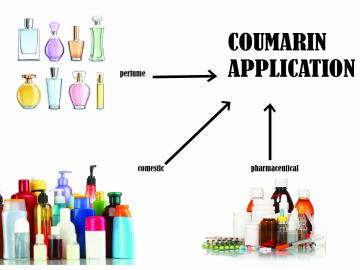Coumarin is characterized by a sweet odor, often compared to the scent of fresh hay, woodruff, or vanilla. Due to its recognizable, pleasant odor and the possibility to act as a fixative and enhancing agent in perfume, coumarins have been used in the perfume industry since 1882. In the literature, coumarin aroma has been often described as a sweet-scented creamy vanilla bean aroma with heavy nut-like tones, but not sharp or brilliant. Coumarin has also been used as a fragrance substance in other cosmetic preparations, such as shower gels, shampoo, toothpaste, toilet soaps, intimate soaps, shaving foams, body creams, face creams, hand creams, deodorants, sunscreens, aftershaves and lipsticks. In addition, it has been used in tobacco to give the product a better taste and aroma thereby increasing the attractiveness of these products.
Coumarin and its derivatives possess a wide range of biological properties that primarily depend on their chemical structure. For this reason, they have been applied in a wide range of pharmacological applications such as antimicrobial agents, antioxidants, anti-inflammatories, anti-HIV agents, anticancer agents, anticoagulants, antiviral agents, antituberculosis agents. Therefore, numerous different coumarin properties have led to their application in drug production, cosmetics, agrochemicals, optical brighteners, dispersed fluorescent, and laser dyes, as well as in the food industry.

After coumarin was synthesized in 1868, it was first put on the market as a flavoring substance. However, since coumarin has been found to cause liver toxicity in rats and dogs that were fed with coumarin-containing food, the usage of coumarin as a flavoring substance has become questionable. Since then, although there was no existing data on carcinogenicity and mutagenicity in humans, coumarin was withdrawn from usage in the USA in 1954, based on hepatotoxic results in rats and dogs. Some later research indicated that coumarin may be related to cancer effects, but it has not yet been confirmed if coumarin has a genotoxic effect on humans. However, according to the new European aroma law, coumarin may be present in foods only naturally or as a flavoring obtained from natural raw materials (as is the case with cinnamon).
Source: Review on Natural Coumarin Lead Compounds for Their Pharmacological Activity (K. N. Venugopala, V. Rashmi, and B. Odhav)
Medical Information: It is not the intention of Tech-Vina to provide specific medical advice, but rather to provide users with information to better understand health and disease. Specific medical advice will not be provided, and Tech-Vina urges you to consult with a qualified health professional for diagnosis and for answers to your personal medical questions.
